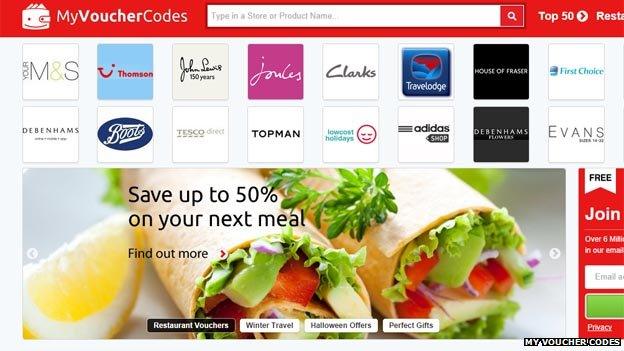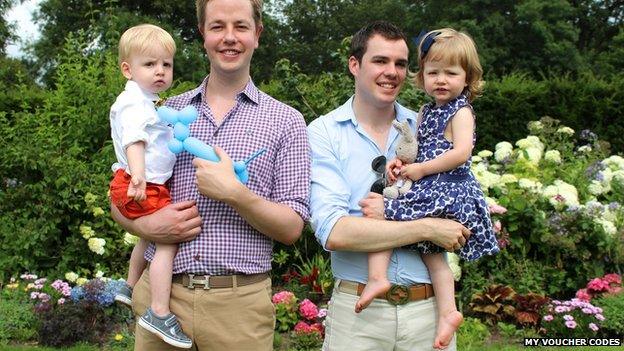The king of discount voucher codes
- Published

Self-made multi-millionaire Mark Pearson traces the origin of his drive to succeed in life back to the Christmas he and his mother and sister spent in a women's refuge in Liverpool.
He was junior school age at the time, and his mother was fleeing domestic violence.
"I felt that I was now the only man in the family, and that drove me," says 34-year-old Mr Pearson.
"At nine or 10 I couldn't do anything, but over time I kept thinking, 'how could I be the breadwinner?'"
After moving to London aged 18, first to be a chef and then run his own floristry business, in 2006 Mr Pearson came up with the idea of launching a website that listed all the available retail and restaurant discount vouchers.
Aged 27 at the time, he called the new business My Voucher Codes, and started running it from a laptop while sitting on his sofa in a rented flat above a shop in south London. The website was an immediate hit with people who like a bargain.
In the first year, his turnover was £300,000, then grew each subsequent year to £1m, £3m, and £10m, with a profit margin of more than 50%.
Today, My Voucher Codes remains the most popular discount website in the UK, and Mr Pearson's personal fortune is valued at more than £60m.
But how did Mr Pearson get the idea, and how does the website make its money?
'Neat business model'
Put simply, My Voucher Codes gets paid a referral fee every time someone uses a discount code listed on its website or weekly email newsletter.

My Voucher Codes offers discounts from thousands of retailers and restaurants
So whether you're ordering something online or printing out a paper voucher to take to a restaurant, if you get the code from My Voucher Codes, then it gets a commission from the company in question, be it supermarket group Tesco, or Pizza Express.
Today, more than 60,000 businesses use My Voucher Codes, and the firm has sister websites in France, Germany and the US. In the UK alone, more than six million people are subscribed to its weekly offers email, and many more use it on an ad hoc basis.
It's not a bad state of affairs for Mr Pearson, who set up the company's first website for just £300, and had no formal training in computers in general, or ecommerce specifically.

Mr Pearson was Ernst & Young's 2011 young entrepreneur of the year
The idea for My Voucher Codes came to Mr Pearson while he was running his independent floristry business.
As the firm was successful, its website was getting a healthy amount of traffic.
As a result, Mr Pearson was approached by flower industry giants Inter Flora and Flowers Direct, which both asked if they could put discount code banners for their businesses on his web pages, and then pay him a commission for each resulting sale.
Mr Pearson agreed, and soon he found he was earning more money in commissions than he was selling his own roses.
"I was thinking this is a neat business model," he says. "Unlike roses, I was suddenly selling something that didn't cost me anything to buy.

Mr Pearson has a home in Barbados, but he has been too busy to visit for the past three years
"And so the idea for My Voucher Codes just clicked. I chose the name, spent £300 getting the website built, and the rest is history."
My Voucher Codes was launched in November 2006 as the UK's first such discount offers website.
Within two years, Mr Pearson had earned enough money to buy a house for himself in London, and another for his mother back in Liverpool. In both cases he didn't need to take out a mortgage.
As the business grew, he eventually took on staff and opened an office in Croydon, south London. The company then moved to its current base near the Thames in London Bridge, and has 110 staff.

Online affiliate marketing
When Mr Pearson first started the business, he didn't go directly to retailers or restaurant groups to ask them for discount vouchers to fill his website.
Instead, he pulled in vouchers that those firms had placed elsewhere on the internet, such as on news or magazine websites.
So how was Mr Pearson able to secure commission payments for vouchers that hadn't been directly given to him to display?
Welcome to the mysterious and complex world of online affiliate marketing. Explaining how it works is not easy, but here goes....
If an online retailer wants to place a voucher or other banner advert on the internet, instead of approaching popular websites one by one, it can instead save a lot of time and hassle by using an affiliate marketing group.
This is typically a network of thousands of websites that will all carry the advert.
So all Mr Pearson had to do was sign up My Voucher Codes to a number of affiliate marketing groups, and then he could pull in any voucher given to a specific group of which he was a member.
He says he started to learn all about this while running the floristry business, and then by viewing, and asking questions in, online business forums.

Earlier this year, Mr Pearson sold My Voucher Codes for £55m, and as he owned more than 90% of it he pocketed most of the money.

Mr Pearson and his partner Aaron have surrogate twins
The business was bought by mobile payments firm Monitise, which is based in the City of London.
Mr Pearson remains in charge of My Voucher Codes, which is run as a stand-alone subsidiary.
He hopes that My Voucher Codes can benefit from Monitise's technology to move more into offering discount codes via mobile phones.
For all Mr Pearson has achieved, he says he is most proud of being able to buy his mother a house.
He also employs his mum in the business, where from her home in Liverpool - or at the family villa he bought in Barbados - she is the firm's quality control officer.
"I bought the place in Barbados three years ago, but I have been too busy to go back since," says Mr Pearson. "But mum now gets to spend six months of the year in Liverpool, and six in Barbados."